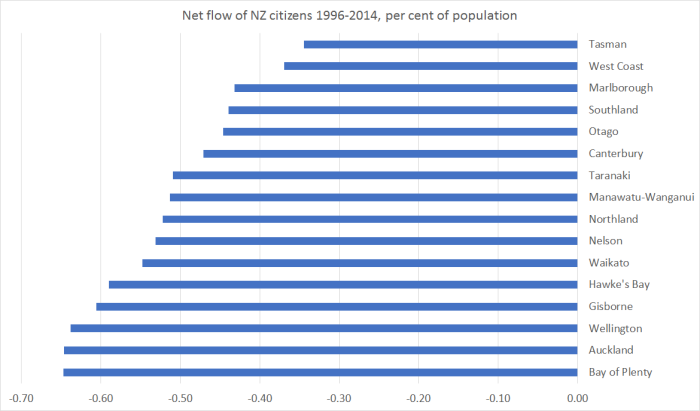Having not lived anywhere else in New Zealand since I was 10, I’m not quite sure.
Yesterday I was filming an interview in which one of the questions the interviewer asked was whether Auckland house prices could be explained, at least in part, by an influx of New Zealanders, whether returning from overseas or moving to Auckland from elsewhere in New Zealand. I noted that the data actually still showed a net outflow of New Zealanders from Auckland to other countries in 2016 (albeit much smaller than in earlier years), and that Census data had suggested a modest net outflow of Aucklanders to the rest of New Zealand since the mid 1990s, and that that pattern seemed unlikely to have changed in the years since the last census.
All of which got me curious. If New Zealanders were still (net) leaving Auckland for abroad, what was happening in other regions of the country. Were there places where there was a net inflow of returning New Zealanders? As it happened, the answer proved to be most of them.

Auckland and Wellington were, in fact, the outliers.
Here is a more aggregated look at the same data.

New Zealanders (net) came back last year to the rest of the North Island, and to the South Island, but not to Auckland or Wellington.
I wouldn’t want to make too much of it. It is, after all, one year’s data, and has all the pitfalls of the PLT data (self-reported intentions and all that).
But it did bring to mind some analysis from The Treasury that I highlighted a couple of weeks ago
As agglomeration and clustering theory predicts, our more urban services-based regional economies (Auckland and Wellington and to a lesser extent Christchurch) are relatively more productive and generate higher incomes than our more resource-based regional economies.
Our Treasury preference is usually to encourage or permit the continued concentration of economic activity in key centres (forces of agglomeration) where returns are expected to be greatest. Resources and activities should be allowed to flow betwen regions over time.
New Zealanders don’t seem to have been convinced by our officials’ analysis of the prospects and opportunities within New Zealand.
What about over a longer period? Here is the average annual net outflow of New Zealand citizens from each regional council area, as a per cent of that region’s population each year, for the period 1996 to 2014 (ie from when the data start to just prior to the current sharp reduction in the overall outflow of New Zealanders).

Wellington and Auckland were losing just over 0.6 per cent of their population each year as New Zealand citizens left those regions for abroad. But so were the Bay of Plenty and Gisborne. (What is, perhaps, more striking is how much lower the net outflow rate abroad was from the South Island). And in the last year, New Zealanders flowed into Gisborne and the Bay of Plenty, and they still flowed out of Wellington and Auckland.
I can think of various stories why this might be. Auckland, presumably, has the highest share of naturalised citizens, and perhaps there is more of tendency for those new citizens to leave, than for natives? But if so, it doesn’t explain the previous 20 years of Wellington, Bay of Plenty or Gisborne. And while house prices are ruinously high in Auckland, they are nowhere near so bad in Wellington. Perhaps there is something in a story about Auckland and Wellington people being more “internationally connected” – but again, over almost 20 years, the outflow rates were the same in the Bay of Plenty and Gisborne. And perhaps, for all the talk of agglomeration opportunities, and a focus on Auckland and Wellington, the economic opportunities, and overall prospective living standards, just aren’t really there in Auckland and Wellington. The regional per capita GDP data certainly support that story for Auckland.
Perhaps the patterns will change again this year – and there is quite a bit of year-to-year variation in the regional outflow rates – but for now, despite all the talk of “problems of success“, or “quality problems“, the migration data suggest New Zealanders when deciding whether to stay or go, and where to come back to if they do, don’t seem to share the sense of Wellington and Auckland as success stories.
Other interpretations/perspectives most welcome.